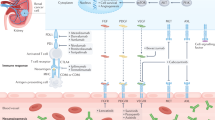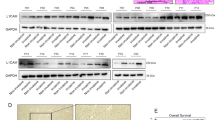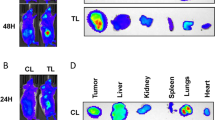Abstract
The most common type of malignancy in the adult kidney is clear cell renal cell carcinoma (ccRCC), for which antiangiogenic therapy with surgery is currently the standard treatment. Although overall survival of patients with metastatic ccRCC has been substantially extended by antiangiogenic therapy with agents such as sorafenib and sunitinib, patients almost certainly go on to develop resistance, or present at the time of treatment with primary resistance. This eventuality implies that our knowledge of the processes involved in tumour angiogenesis in ccRCC is superficial. Increasing evidence has shown that a solid tumour can, during invasion and expansion, 'hijack' pre-existing blood vessels and integrate them into the tumour vasculature. This approach to expanding the tumour vasculature is referred to as vessel co-option. In this Perspectives article, I argue that vessel co-option likely occurs in ccRCC, along with the complementary processes of vessel remodelling and extratumoural angiogenesis. Exploring the underlying molecular mechanisms of these complicated vasculature developments in ccRCC might provide new opportunities to enhance the efficacy of antiangiogenic therapy.
This is a preview of subscription content, access via your institution
Access options
Subscribe to this journal
Receive 12 print issues and online access
$209.00 per year
only $17.42 per issue
Buy this article
- Purchase on Springer Link
- Instant access to full article PDF
Prices may be subject to local taxes which are calculated during checkout


Similar content being viewed by others
References
Holleb, A. I. & Folkman J. Tumor angiogenesis. CA Cancer J. Clin. 22, 226–229 (1972).
Qin, L., Bromberg-White, J. L. & Qian, C. N. Opportunities and challenges in tumor angiogenesis research: back and forth between bench and bed. Adv. Cancer Res. 113, 191–239 (2012).
Giridharan, W., Hughes, J., Fenton, J. E. & Jones, A. S. Lymph node metastases in the lower neck. Clin. Otolaryngol. Allied Sci. 28, 221–226 (2003).
Qian, C. N., Resau, J. H. & Teh, B. T. Prospects for vasculature reorganization in sentinel lymph nodes. Cell Cycle 6, 514–517 (2007).
Siegel, R., Naishadham, D. & Jemal, A. Cancer statistics, 2012. CA Cancer J. Clin. 62, 10–29 (2012).
Sunela, K. L. et al. Prognostic factors and long-term survival in renal cell cancer patients. Scand. J. Urol. Nephrol. 43, 454–460 (2009).
Zhang, Z. L. et al. Stage T1N0M0 renal cell carcinoma: the prognosis in Asian patients. Chin. J. Cancer 30, 772–778 (2011).
Zhang, Z. L. et al. Oncological outcome of surgical treatment in 336 patients with renal cell carcinoma. Chin. J. Cancer 29, 995–999 (2010).
Herrmann, E. et al. Sequential therapies with sorafenib and sunitinib in advanced or metastatic renal cell carcinoma. World J. Urol. 29, 361–366 (2011).
Motzer, R. J. et al. Survival and prognostic stratification of 670 patients with advanced renal cell carcinoma. J. Clin. Oncol. 17, 2530–2540 (1999).
Powles, T. Second-line therapy after VEGF targeted therapy in metastatic renal cancer: a law of diminishing returns. Clin. Genitourin. Cancer 10, 67–68 (2012).
Qian, C. N., Huang, D., Wondergem, B. & Teh, B. T. Complexity of tumor vasculature in clear cell renal cell carcinoma. Cancer 115 (Suppl. 10), 2282–2289 (2009).
Huang, D. et al. Sunitinib acts primarily on tumor endothelium rather than tumor cells to inhibit the growth of renal cell carcinoma. Cancer Res. 70, 1053–1062 (2010).
Chen, F. H. et al. Vasculatures in tumors growing from preirradiated tissues: formed by vasculogenesis and resistant to radiation and antiangiogenic therapy. Int. J. Radiat. Oncol. Biol. Phys. 80, 1512–1521 (2012).
Weisshardt, P. et al. Tumor vessel stabilization and remodeling by anti-angiogenic therapy with bevacizumab. Histochem. Cell Biol. 137, 391–401 (2012).
Leenders, W. P., Küsters, B. & de Waal, R. M. Vessel co-option: how tumors obtain blood supply in the absence of sprouting angiogenesis. Endothelium 9, 83–87 (2002).
Yao, X. et al. Two distinct types of blood vessels in clear cell renal cell carcinoma have contrasting prognostic implications. Clin. Cancer Res. 13, 161–169 (2007).
Goel, S. et al. Normalization of the vasculature for treatment of cancer and other diseases. Physiol. Rev. 91, 1071–1121 (2011).
Foo, S. S. et al. Ephrin-B2 controls cell motility and adhesion during blood-vessel-wall assembly. Cell 124, 161–173 (2006).
Lee, A. et al. Inhibition of cyclooxygenase-2 disrupts tumor vascular mural cell recruitment and survival signaling. Cancer Res. 66, 4378–4384 (2006).
Stratman, A. N., Schwindt, A. E., Malotte, K. M. & Davis, G. E. Endothelial-derived PDGF-BB and HB-EGF coordinately regulate pericyte recruitment during vasculogenic tube assembly and stabilization. Blood 116, 4720–4730 (2010).
Döme, B., Paku, S., Somlai, B. & Tímár, J. Vascularization of cutaneous melanoma involves vessel co-option and has clinical significance. J. Pathol. 197, 355–362 (2002).
Cao, Y. et al. Pericyte coverage of differentiated vessels inside tumor vasculature is an independent unfavorable prognostic factor for patients with clear cell renal cell carcinoma. Cancer 119, 313–324 (2012).
O'Keeffe, M. B. et al. Investigation of pericytes, hypoxia, and vascularity in bladder tumors: association with clinical outcomes. Oncol. Res. 17, 93–101 (2008).
Fergelot, P. et al. The experimental renal cell carcinoma model in the chick embryo. Angiogenesis 16, 181–194 (2012).
Jain, R. K. Normalizing tumor vasculature with anti-angiogenic therapy: a new paradigm for combination therapy. Nat. Med. 7, 987–989 (2001).
von Baumgarten, L. et al. Bevacizumab has differential and dose-dependent effects on glioma blood vessels and tumor cells. Clin. Cancer Res. 17, 6192–6205 (2011).
Baluk, P., Hashizume, H. & McDonald, D. M. Cellular abnormalities of blood vessels as targets in cancer. Curr. Opin. Genet. Dev. 15, 102–111 (2005).
Jain, R. K. Normalization of tumor vasculature: an emerging concept in antiangiogenic therapy. Science 307, 58–62 (2005).
Qian, C. N. et al. Preparing the “soil”: the primary tumor induces vasculature reorganization in the sentinel lymph node before the arrival of metastatic cancer cells. Cancer Res. 66, 10365–10376 (2006).
Eberhard, A. et al. Heterogeneity of angiogenesis and blood vessel maturation in human tumors: implications for antiangiogenic tumor therapies. Cancer Res. 60, 1388–1393 (2000).
Ding, Y., Song, N. & Luo, Y. Role of bone marrow-derived cells in angiogenesis: focus on macrophages and pericytes. Cancer Microenviron. 5, 225–236 (2012).
Garrett, H. E., Diethrich, E. B. & DeBakey, M. E. Myocardial revascularization. Surg. Clin. North Am. 46, 863–871 (1966).
Kwei, S. et al. Early adaptive responses of the vascular wall during venous arterialization in mice. Am. J. Pathol. 164, 81–89 (2004).
Hillmeister, P. et al. Arteriogenesis is modulated by bradykinin receptor signaling. Circ. Res. 109, 524–533 (2011).
Farnsworth, R. H. et al. A role for bone morphogenetic protein-4 in lymph node vascular remodeling and primary tumor growth. Cancer Res. 71, 6547–6557 (2011).
Doyle, M. E., Perley, J. P. & Skalak, T. C. Bone marrow-derived progenitor cells augment venous remodeling in a mouse dorsal skinfold chamber model. PLoS ONE 7, e32815 (2012).
Miles, K. A. et al. In vivo assessment of neovascularization of liver metastases using perfusion CT. Br. J. Radiol. 71, 276–281 (1998).
Halin, S., Rudolfsson, S. H., Van Rooijen, N. & Bergh, A. Extratumoral macrophages promote tumor and vascular growth in an orthotopic rat prostate tumor model. Neoplasia 11, 177–186 (2009).
Acknowledgements
The author is supported by grants from the National Natural Science Foundation of China (Grant No. 81030043 and 81272340), and the Van Andel Foundation. The author thanks Paul Elson, Quantitative Health Science (The Cleveland Clinic, OH) for statistical analyses and David Nadziejka (Grand Rapids, MI) for the critical reading of the manuscript.
Author information
Authors and Affiliations
Ethics declarations
Competing interests
The author declares no competing financial interests.
Rights and permissions
About this article
Cite this article
Qian, CN. Hijacking the vasculature in ccRCC—co-option, remodelling and angiogenesis. Nat Rev Urol 10, 300–304 (2013). https://doi.org/10.1038/nrurol.2013.26
Published:
Issue Date:
DOI: https://doi.org/10.1038/nrurol.2013.26
This article is cited by
-
Vessel co-option and resistance to anti-angiogenic therapy
Angiogenesis (2020)
-
Vessel co-option in cancer
Nature Reviews Clinical Oncology (2019)
-
VEGFR2 regulates endothelial differentiation of colon cancer cells
BMC Cancer (2017)
-
Tumor angiogenesis and vascular normalization: alternative therapeutic targets
Angiogenesis (2017)
-
Revisiting tumor angiogenesis: vessel co-option, vessel remodeling, and cancer cell-derived vasculature formation
Chinese Journal of Cancer (2016)



